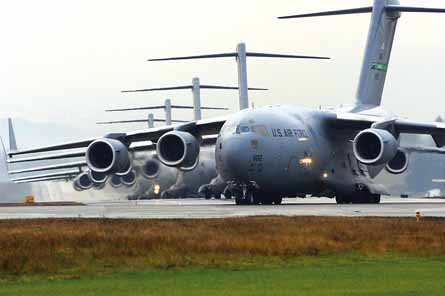Boeing is fixing new fuselage cracks found on US Air Force C-17s, while senior commanders have made public an internal dispute over the future of the heavy airlifter's production line.
Testifying before a House of Representatives subcommittee on air and land forces, Air Mobility Command chief Gen Arthur Lichte revealed the C-17's structural problem for the first time.
Asked to elaborate, a Boeing source says the stress cracks are located beneath and forward of the wing. But he adds: "The cracks are a minor occurrence, and don't pose a safety hazard for the aircraft or flight crews. There's no impact on the operational readiness of these planes and the cracks are being fixed during regularly scheduled maintenance with a simple technique."
Lichte blames the problem on fatigue stress imposed by using thrust reversers on the aircraft's Pratt & Whitney F117-100 turbofan engines, as the formerly strategic airlifter often now performs the more intense, tactical airlift role.
The same hearing also revealed that Lichte and his counterpart at US Transportation Command, Gen Norton Schwartz, disagree over the need to keep the future of the C-17 production line open-ended. The dispute arises from a quirk in the USAF's budget plans. Next year's spending proposal includes no funds to buy more C-17s, and if this is accepted, Boeing could be forced to shut down its line in Long Beach, California, after the USAF's 190th aircraft is delivered in June 2009.

Instead, the USAF wants Congress to add funds in an emergency supplemental budget to buy up to 15 more C-17s, allowing production to continue for at least one more year.
Both Schwartz and Lichte agree the USAF needs a combined strategic airlifter fleet of 205 C-17s, plus 52 Lockheed Martin C-5Bs (upgraded to C-5Ms) and 59 C-5As. But consensus between the officials breaks down beyond this point.
In Lichte's view, the air force may need to buy even more C-17s, depending on the results of two studies due to report in 2009. But Schwartz believes 205 C-17s is the maximum needed, regardless of the studies.
"I don't presume that those things that are yet to be assessed will add to that number," Schwartz told lawmakers on 1 April. "Some people do, but I am not there yet." Going beyond a 205-aircraft fleet would require capacity cuts elsewhere, he said, adding: "This probably means [retiring] C-5As."
But Lichte points out that transporting the US Army's Future Combat System equipment is not factored into the USAF's current requirements, with the pending studies to be the first to include such needs. "I would like to see the C-17 production line kept open," he adds.
Source: FlightGlobal.com



















